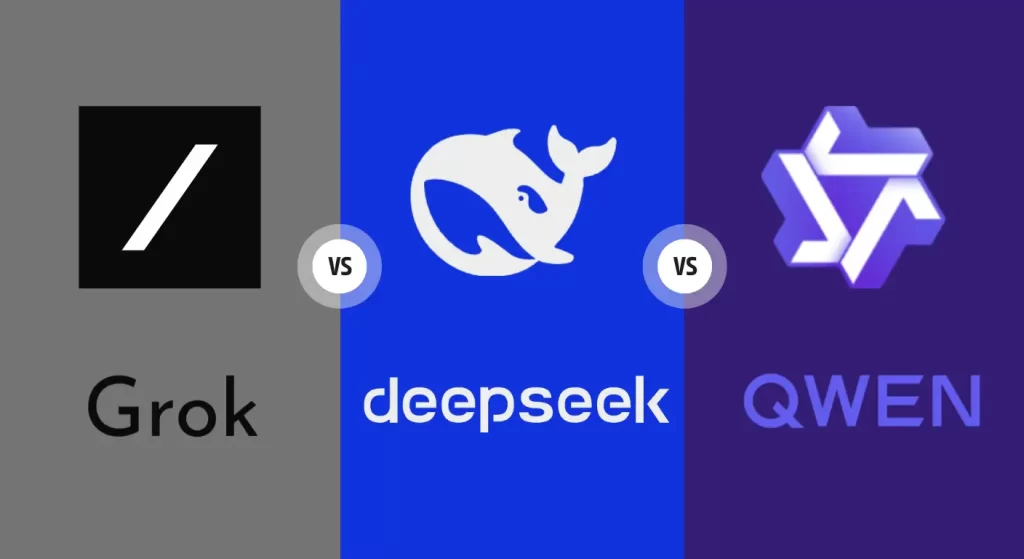The rapid evolution of artificial intelligence has given rise to a new generation of large language models (LLMs) designed to tackle diverse tasks, from creative writing to technical problem-solving. Among the latest contenders in this space are Qwen 2.5 Max (developed by Alibaba Cloud), Deepseek R1 (from the Chinese AGI research lab DeepSeek), and Grok 3 (Elon Musk’s xAI’s flagship model). Each model brings unique strengths, whether in multilingual support, coding efficiency, or real-time data integration.
This article dives deep into their architectures, performance benchmarks, use cases, and ethical implications to help users and developers choose the right tool for their needs.
Table of Contents
Deepseek R1 vs Qwen 2.5 Max vs Grok 3
The competition between Large Language Models (LLMs) is very strong. Big companies like OpenAI with ChatGPT and Google with Gemini are fighting for the top spot. But now, new models like Deepseek R1, Qwen 2.5 Max, and Grok 3 make things more complicated. Each of these models has its own special skills and targets specific needs.
Deepseek R1 aims to be cost-effective and is very good at coding and math. In contrast, Alibaba's Qwen 2.5 Max offers large context windows and is great in many languages, especially Asian languages. Grok 3 is more mysterious, but it is said to have great intelligence, though we still do not know exactly what it can do.
Qwen 2.5 Max Overview
Qwen 2.5 Max is the latest iteration of Alibaba’s Tongyi Qianwen series, a multimodal LLM excelling in text and image processing. Trained on a vast corpus of multilingual data, it supports over 100 languages, with a strong emphasis on Chinese and English. The model is tailored for enterprise applications, offering robust APIs for integration into e-commerce, customer service, and content generation workflows. Its “Max” designation suggests it is the largest variant in the Qwen family, likely exceeding 100 billion parameters.
Deepseek R1 Overview
Deepseek R1 focuses on reasoning and coding efficiency. Developed by DeepSeek, a lab dedicated to advancing artificial general intelligence (AGI), R1 is optimized for low-latency tasks like code generation, data analysis, and logical problem-solving. Unlike its bulkier counterparts, R1 prioritizes speed and resource efficiency, potentially operating with fewer parameters (estimates suggest ~30 billion) while maintaining competitive performance in specialized domains.
Grok 3 Overview
Grok 3, xAI’s third-generation model, is designed for real-time knowledge integration and a “rebellious” personality. Trained on data from X (formerly Twitter) and other social platforms, it emphasizes humor, sarcasm, and up-to-date information retrieval. Grok 3 is rumored to rival GPT-4 in scale, with speculative parameter counts exceeding 300 billion. Its integration with X gives it unique access to trending topics, making it ideal for social media interactions and dynamic content creation.
Technical Specifications
| Feature | Qwen 2.5 Max | Deepseek R1 | Grok 3 |
|---|---|---|---|
| Architecture | Transformer-based | Sparse Transformer | Mixture-of-Experts |
| Parameters | ~120B | ~30B | ~300B (speculative) |
| Training Data | Multilingual web text, books, images | Code repositories, technical documents | Social media, real-time web data |
| Modalities | Text, images | Text | Text |
| Inference Speed | Moderate | High | Variable (cloud-based) |
Key Insights:
- Qwen 2.5 Max leverages multimodal capabilities for tasks like image captioning and cross-lingual translation.
- Deepseek R1 uses a sparse architecture to reduce computational overhead, enabling faster inference on consumer-grade hardware.
- Grok 3 employs a mixture-of-experts (MoE) design, activating subsets of neurons for specific tasks, balancing performance and efficiency.
Performance Benchmarks
To objectively compare these models, we examine their scores on industry-standard benchmarks:
- MMLU (Massive Multitask Language Understanding)
- Qwen 2.5 Max: 82% (excels in multilingual and general knowledge tasks).
- Deepseek R1: 75% (strong in STEM and coding subsets).
- Grok 3: 78% (performs well in social sciences and current events).
- HellaSwag (Commonsense Reasoning)
- Qwen: 88%
- Deepseek: 83%
- Grok: 85%
- HumanEval (Coding)
- Qwen: 65%
- Deepseek: 72%
- Grok: 58%
Takeaways:
- Qwen dominates multilingual and general-purpose tasks.
- Deepseek leads in coding and technical problem-solving.
- Grok shines in real-time knowledge and creative writing.
Use Cases and Applications
Qwen 2.5 Max
- Enterprise Solutions: Deployable via Alibaba Cloud for customer support automation and market analysis.
- Content Creation: Generates SEO-friendly articles, product descriptions, and ad copy in multiple languages.
- Education: Powers tutoring systems for language learning and technical subjects.
Deepseek R1
- Software Development: Autocompletes code, debugs errors, and generates documentation.
- Data Analysis: Extracts insights from logs, spreadsheets, and research papers.
- IoT Integration: Runs efficiently on edge devices for real-time analytics.
Grok 3
- Social Media Management: Crafts engaging posts, responds to trends, and moderates discussions.
- Creative Writing: Generates scripts, satire, and interactive storytelling.
- Journalism: Summarizes breaking news with real-time data from X.
Strengths and Weaknesses
| Model | Strengths | Weaknesses |
|---|---|---|
| Qwen 2.5 Max | Multilingual, multimodal, enterprise-grade | High computational costs |
| Deepseek R1 | Fast inference, coding proficiency | Limited to text, narrower scope |
| Grok 3 | Real-time data, humor, creativity | Potential bias from social media data |
User Experience
- Qwen 2.5 Max: Integrated into Alibaba Cloud’s ecosystem, offering plugins for business users. Steep learning curve for non-technical users.
- Deepseek R1: Lightweight API ideal for developers; lacks a user-friendly GUI.
- Grok 3: Accessible via X’s premium subscription, with a playful, conversational interface.
Ethical Considerations
All three models face challenges around bias and misinformation:
- Qwen may reflect cultural biases in its training data, particularly Sinocentric perspectives.
- Deepseek’s technical focus risks perpetuating errors in code or scientific content.
- Grok 3’s reliance on social media data could amplify harmful trends or conspiracy theories.
Future Developments
- Qwen: Expanding into video processing and 3D modeling.
- Deepseek: Enhancing mathematical reasoning for research applications.
- Grok: Integrating audio and video inputs for richer interactions.
Conclusion
Choosing between Qwen 2.5 Max, Deepseek R1, and Grok 3 depends on specific needs:
- Enterprises prioritizing multilingual support should opt for Qwen.
- Developers seeking coding efficiency will prefer Deepseek.
- Creators and social media teams will find Grok 3’s real-time edge invaluable.
As AI continues to evolve, these models represent the cutting edge of what’s possible—each pushing boundaries in their unique domains.





